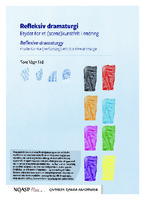Reflexive dramaturgy
Études for the (performing)arts in a time of change
| dc.contributor.author | Vagn Lid, Tore | |
| dc.date.accessioned | 2019-02-05 10:36:45 | |
| dc.date.accessioned | 2020-04-01T10:55:00Z | |
| dc.date.available | 2020-04-01T10:55:00Z | |
| dc.date.issued | 2018 | |
| dc.identifier | 1004152 | |
| dc.identifier | OCN: 1100541177 | en_US |
| dc.identifier.uri | http://library.oapen.org/handle/20.500.12657/25928 | |
| dc.description.abstract | The fact that you are reading these words means you have already stepped over the threshold of a collection of what the author calls reflexive études. Here, the author is expanding on the word étude as it is used in music’s most ‘classical’ department, where it denotes a practice piece designed to address an isolated problem of musical technique, and transforms it to serve as a practical thought exercise for the (theatre) field as a whole. The reflexive étude therefore serves as a practical-theoretical exercise in trying to think one’s way to freedom from the (often) unconscious or semi-conscious assumptions and obstacles that the art actor constantly has to contend with. Implicit here is the notion that thinking through also constitutes an exercise and that the art of thinking is inextricably associated with art in general. Like musical exercises, the reflexive études are characteristically specific: each focuses on practice relevant to something particular – perhaps one performance, an issue of acting technique, an acute theatre -sociological situation, or the question of what a theatre script can and should look like. The ambition is to develop what I have called a reflexive dramaturgy. This conception of dramaturgy does not limit itself to analyses of the theatrical text, or to the theatre’s arsenal of calculated stage effects, but is capable of expanding its reach to identify other kinds of action that exert a powerful influence, despite their being seemingly inconspicuous. In this sense, reflexive dramaturgy becomes a kind of theoretical practice that seeks to identify and articulate those actions which (reflexively) set the limits for aesthetic experience, but which are often insufficiently covered by the ways that art and theatrical art view themselves. | |
| dc.language | Norwegian | |
| dc.language | English | |
| dc.subject.classification | thema EDItEUR::A The Arts::AB The arts: general topics::ABA Theory of art | en_US |
| dc.subject.classification | thema EDItEUR::A The Arts::AT Performing arts::ATD Theatre studies | en_US |
| dc.subject.classification | thema EDItEUR::A The Arts::AT Performing arts::ATC Individual actors and performers | en_US |
| dc.subject.other | reflexive | |
| dc.subject.other | theatre | |
| dc.subject.other | performing arts | |
| dc.subject.other | dramaturgy | |
| dc.title | Reflexive dramaturgy | |
| dc.title.alternative | Études for the (performing)arts in a time of change | |
| dc.type | book | |
| oapen.abstract.otherlanguage | Den som leser disse ordene, befinner seg nå allerede over terskelen til en samling av det forfatteren har kalt refleksive etyder. Ordet etyde utvides her fra musikkens mest ‘klassiske’ avdeling, hvor det betegner et øvelsesstykke innrettet mot å løse et isolert teknisk-musikalsk problem og transformeres til praktiske tankeøvelser for (scenekunst) feltet som helhet. Den refleksive etyden er derfor valgt som en praktisk teoretisk øvelse i å tenke seg løs fra de (ofte) ubevisste eller halv-bevisste forutsetningene og hindringene som en kunstaktør hele tiden arbeider i, og med. I dette ligger en forståelse av at det å tenke over også er en øvelse, og at kunsten å tenke uløselig henger sammen med kunst overhodet. Ambisjonen er å utvikle det forfatteren har kalt for en refleksiv dramaturgi. I dette ligger en dramaturgi som ikke begrenser seg til analyser av sceneteksten, eller av teaterrommets kalkulerte kunstneriske virkemidler, men som i tillegg evner å utvide sitt søk etter andre, og mindre iøynefallende, men ikke desto mindre virksomme, handlinger. Refleksiv dramaturgi blir slik en type teoretisk praksis som forsøker å lokalisere og artikulere de handlingene som (refleksivt) setter grenser for det estetiske, men som ofte selv ikke er tilstrekkelig del av kunstens og scenekunstnerens selvforståelse. | |
| oapen.identifier.doi | 10.23865/noasp.48 | |
| oapen.relation.isPublishedBy | bf7b42a4-6892-42e3-aaf8-8f32c8470a8b | |
| oapen.relation.isbn | 9788202627232 | |
| oapen.pages | 377 | |
| oapen.place.publication | Oslo | |
| oapen.notes | 2019-02-05 10:31:10, Funder: Khio | |
| oapen.identifier.ocn | 1100541177 |

